Rare 1930s Wurlitzer cinema pipe organ tunes up for Lichfield auction
FOR many, it defines the sparkling sound of the golden age of entertainment.Now a rare 1930s Wurlitzer theatre organ is heading for sale in Lichfield with Richard Winterton Auctioneers.
Not only has this 1936 example of a ‘Mighty Wurlitzer’ cinema pipe organ been rescued then lovingly restored, it has been played by most of Britain’s top organists to the enjoyment of audiences in a bespoke mini theatre built at its owner’s bungalow in a quiet cul-de-sac in Cannock, Staffordshire.
The instrument goes under the hammer at The Lichfield Auction Centre, Wood End Lane, Fradley Park, as Lot 1201 in the Antiques & Home Sale on Tuesday, May 21, starting at 9.30am.
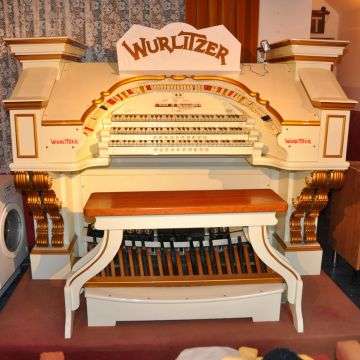 The Mighty Wurlitzer – ‘a living instrument when it’s all up and firing away’. The console has been resprayed to an amazing standard.
The Mighty Wurlitzer – ‘a living instrument when it’s all up and firing away’. The console has been resprayed to an amazing standard.Thought to be one of around 20 operational theatre Wurlitzers in the UK today, the console has been resprayed to such a high standard it has been lauded as one of the best-looking cinema organs in the country.
As in a traditional pipe organ, a theatre organ uses pressurized air to produce musical tones.
This Wurlitzer has eight ranks of pipes, xylophone, glockenspiel, vibraphone and percussion effects such as bass drum, snare drum and cymbals.
It is also replete with the usual sound effects associated with cinema organs such as bird whistle, train whistle and fire gong, and is in perfect working order.
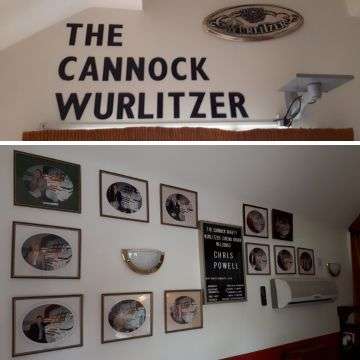 The walls of the mini theatre are decorated with photographs of all the organists who have played the instrument.
The walls of the mini theatre are decorated with photographs of all the organists who have played the instrument.Changes over the years include a new keyboard – replaced after WW2 bomb damage in 1944 – and it now has an electronic piano but otherwise is as it would have been in 1936 with the authentic Wurlitzer sound preserved.
Around 28 American-built Wurlitzers were originally transported to Britain from 1925 until just before the Second World War – the last one shipped was the instrument at Blackpool Opera House, which is still entertaining people on an almost daily basis.
The example going to auction was originally delivered to the UK on October 16 1936 and installed in the newly-built 2,468-seater Granada Cinema in Barking Road, East Ham, London.
It took about six weeks to assemble and tune and organist Donald Thorne officially opened the instrument on November 30 1936.
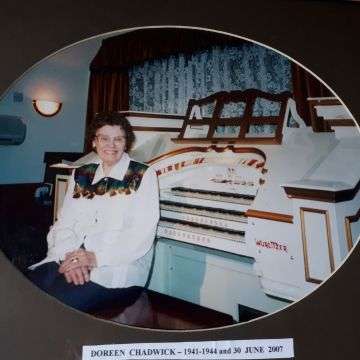 Doreen Chadwick was the organist in East Ham during the war from 1941 to 1944. She was renuited with the Wurlitzer – by then lovingly restored – in Cannock on June 30 2007.
Doreen Chadwick was the organist in East Ham during the war from 1941 to 1944. She was renuited with the Wurlitzer – by then lovingly restored – in Cannock on June 30 2007.The Wurlitzer remained in East Ham until 1975, when it was reinstalled as a novelty item at a station on a miniature railway in Kessington, Suffolk.
It subsequently passed through the hand of two further owners who, despite spending much time and money refurbishing parts, never succeeding in getting it to play again.
The present owner saved the instrument from slowly deteriorating in a container in November 2000 when it was transported and craned into a purpose-built 20-seat mini theatre at his home.
During 2001 it was lovingly restored and rebuilt with guidance from Steve Tovey, The Birmingham Odeon’s master cinema organist, and the assistance of The Cinema Organ Society’s Cameron Lloyd.
The home auditorium opened in November 2001 – almost 65 years after the organ’s original appearance – and was regularly in use until five years ago.
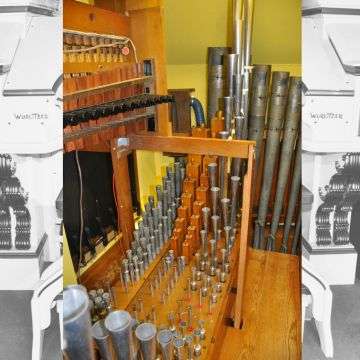 Part of the pipe room.
Part of the pipe room.“Sadly due to my age I now have to sell the instrument as I am unable to squeeze into the tight corners of the pipe chamber to maintain it!” said the owner, who prefers not to be named.
“It is not a small instrument, needing a three-phase power supply for the blower and a room of at least 18 square metres to house the relays and pipework.
“They were fantastic instruments in their time, constructed of timber, leather and steel – the only plastic parts are Bakelite.
“There are but a handful of these left in the UK and it has been wonderful to be custodian of this one for the past 20 years.”
He added: “I describe it as a living instrument when it’s all up and firing away.”
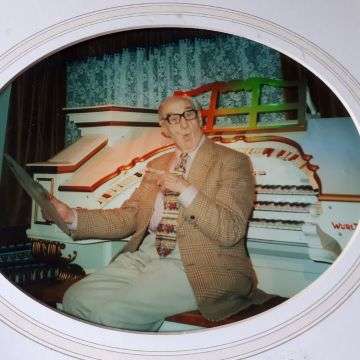 Concert organist Dr Arnold Loxam, whose performances were broadcast on the BBC from the 1940s to the 1960s, visited Cannock on September 28 2002.
Concert organist Dr Arnold Loxam, whose performances were broadcast on the BBC from the 1940s to the 1960s, visited Cannock on September 28 2002.Most of the UK’s famous organists came to Cannock to play the instrument and recordings were made of their performances.
Musicians included Phil Kelsall, resident organist at Blackpool Tower; Nicholas Martin BEM; the late Dr Arnold Loxam, who gave BBC organ concerts from the 1940s to the 1960s; and Britain’s Got Talent finalist Jean Martyn – the Lichfield-born former Cannock teacher played at the mini theatre almost a decade before wowing judges and audiences alike on TV’s BGT.
Auctioneer Richard Winterton said: “What an impressive instrument this is!
“The console has been resprayed to an amazing standard and the original Wurlitzer sound has been carefully retained.
“It has been guided at £5,000 to £7,000 at auction but such an unusual, beautiful item could fetch far more on the day.”
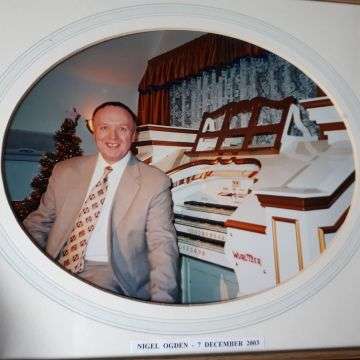 Nigel Ogden presented and performed on the BBC Radio Two programme The Organist Entertains between 1980 and the end of the show's run in 2018. He played the Cannock Wurlitzer on December 7 2003.
Nigel Ogden presented and performed on the BBC Radio Two programme The Organist Entertains between 1980 and the end of the show's run in 2018. He played the Cannock Wurlitzer on December 7 2003.The Cannock Wurlitzer features as Lot 1201 in the Antiques & Home Sale on Tuesday, May 21, at The Lichfield Auction Centre.
The auction catalogue can be viewed online via our Auction Dates page a week before the sale and people can bid online, in the room or by prior arranged telephone bid.
Appointments to view in person, or to get a valuation of any item, can also be organised through Richard Winterton Auctioneers on 01543 251081 or by email to office@richardwinterton.co.uk.
Free home visits for large collections and house clearance quotations are also available.
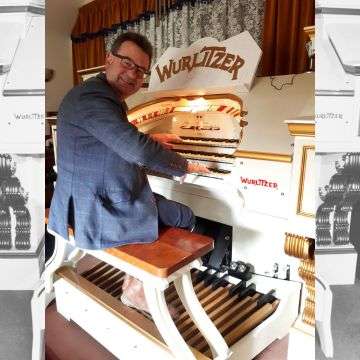 Auctioneer Richard Winterton with the Wurlitzer cinema pipe organ.
Auctioneer Richard Winterton with the Wurlitzer cinema pipe organ.
The history of the East Ham Granada Wurlitzer
This instrument, serial number OPUS 2200, was originally shipped to the UK on October 16 1930 from the Wurlitzer factory in the US.It was installed in the newly-built 2,468-seater Granada Cinema in Barking Road, East Ham, London, and opened on November 30 1936 by organist Donald Thorne.
The organ consisted originally of eight ranks of pipes – the tibia clausa. diaphonic, diapason, clarinet, trumpet, vox humana, flute, violin and violin celeste.
Additionally it has a tuned xylophone, glockenspiel and vibraphone, various percussion effects such as bass drum, snare drum and cymbals and – although this organ never accompanied silent films – special effects such as a bird whistle train whistle and fire gong!
The organ was originally installed in two chambers underneath the stage and remained there until 1975.
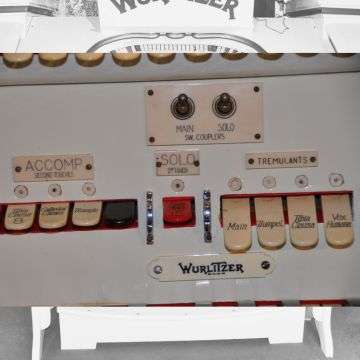 A detail from the console.
A detail from the console.In 1944 as a result of bomb damage the keyboards were replaced and in the 1960s the violin and celeste ranks were replaced by gambas, although the original ranks are now back in place.
As was the fate of many cinemas the East Ham Granada was closed on November 1 1974, reopening in 1976 as a bingo hall.
The organ was removed early in 1975 but not before an LP recording was made by George Welling.
Once removed the organ then had several years reinstalled as a novelty item at a railway station on a miniature railway at Kessingland, Suffolk, before passing through two further owners who, despite spending time and money refurbishing parts of the organ, never actually succeeded in getting it playing again.
The current owner first saw the organ in pieces in November 2000 slowly deteriorating in a container and was persuaded to rescue the instrument.
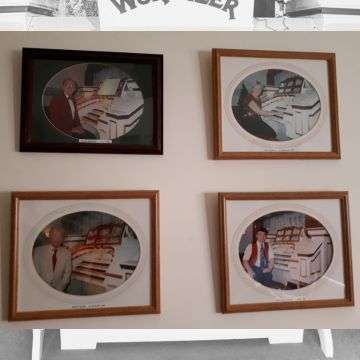 Most of the UK’s most famous organists visited Cannock to play the Wurlitzer including and Britain’s Got Talent finalist Jean Martyn.
Most of the UK’s most famous organists visited Cannock to play the Wurlitzer including and Britain’s Got Talent finalist Jean Martyn.The parts were transported to the purpose-built mini theatre at the new owner’s home in Cannock and rebuilt during 2001 under the guidance of Steve Tovey, The Birmingham Odeon’s master cinema organist, with the assistance of The Cinema Organ Society’s Cameron Lloyd.
The organ was reopened in November 2001 virtually 65 years to the day of its original appearance and since then has been played by most of the UK's top organists.
The console has resprayed to a standard which ranks it among the best-looking cinema organs in the country and the original Wurlitzer sound has been carefully retained.
The only alterations made have been the addition of an electronic piano instead of the real thing, the trumpet rack has been replaced with an English horn and the replacement of the clarinet rank with a Kinura – a reed stop often used in theatre organs for comedic effects.
Otherwise, the instrument is as it would have been in 1936.
